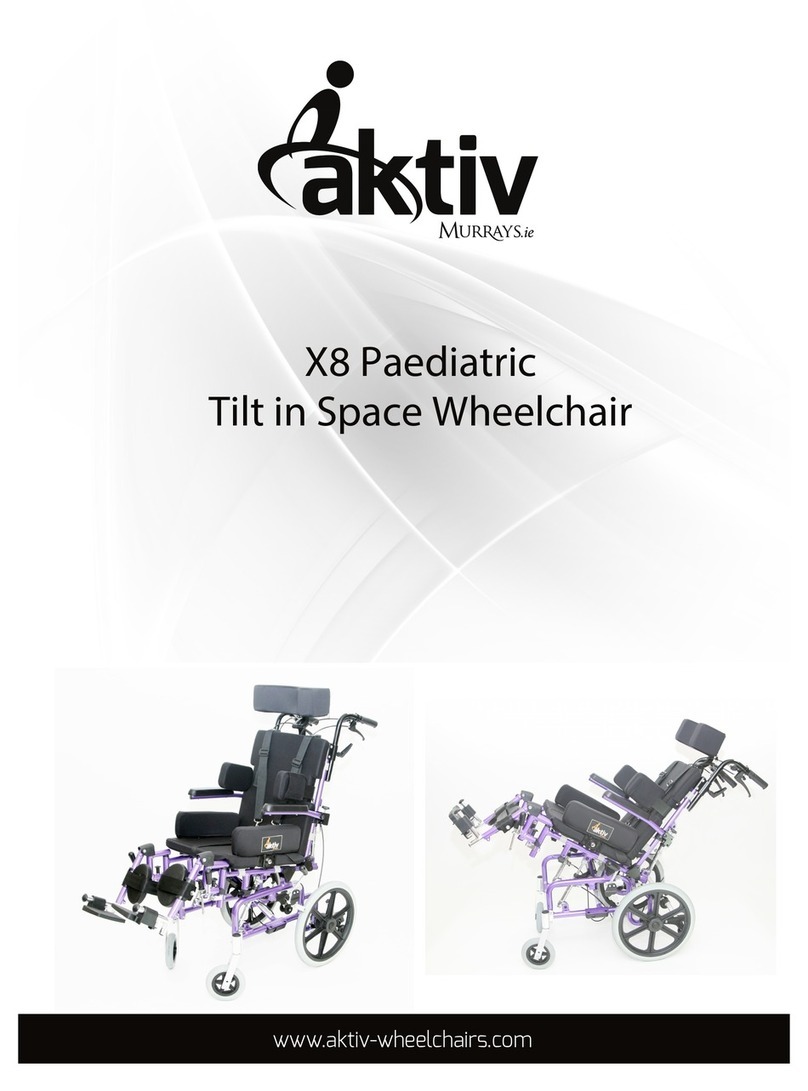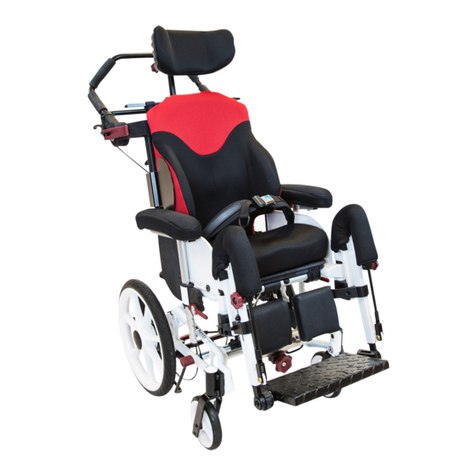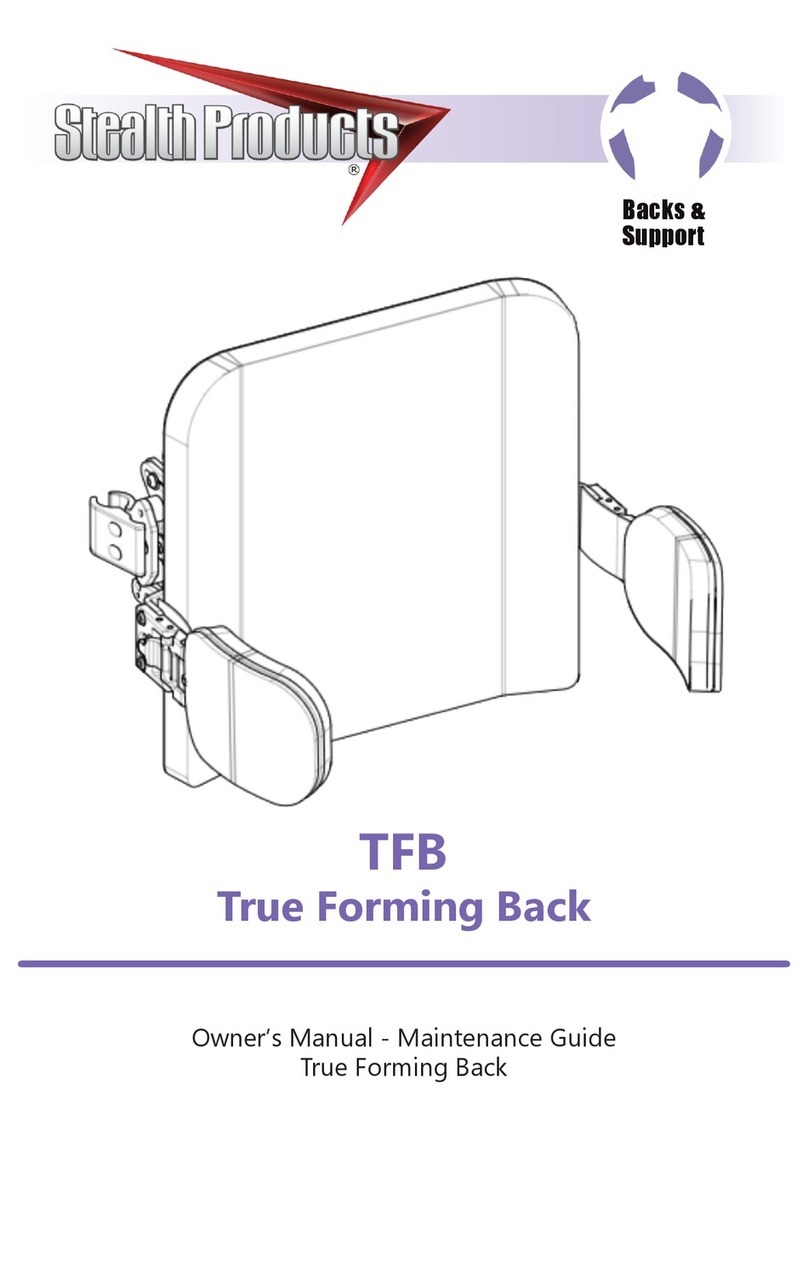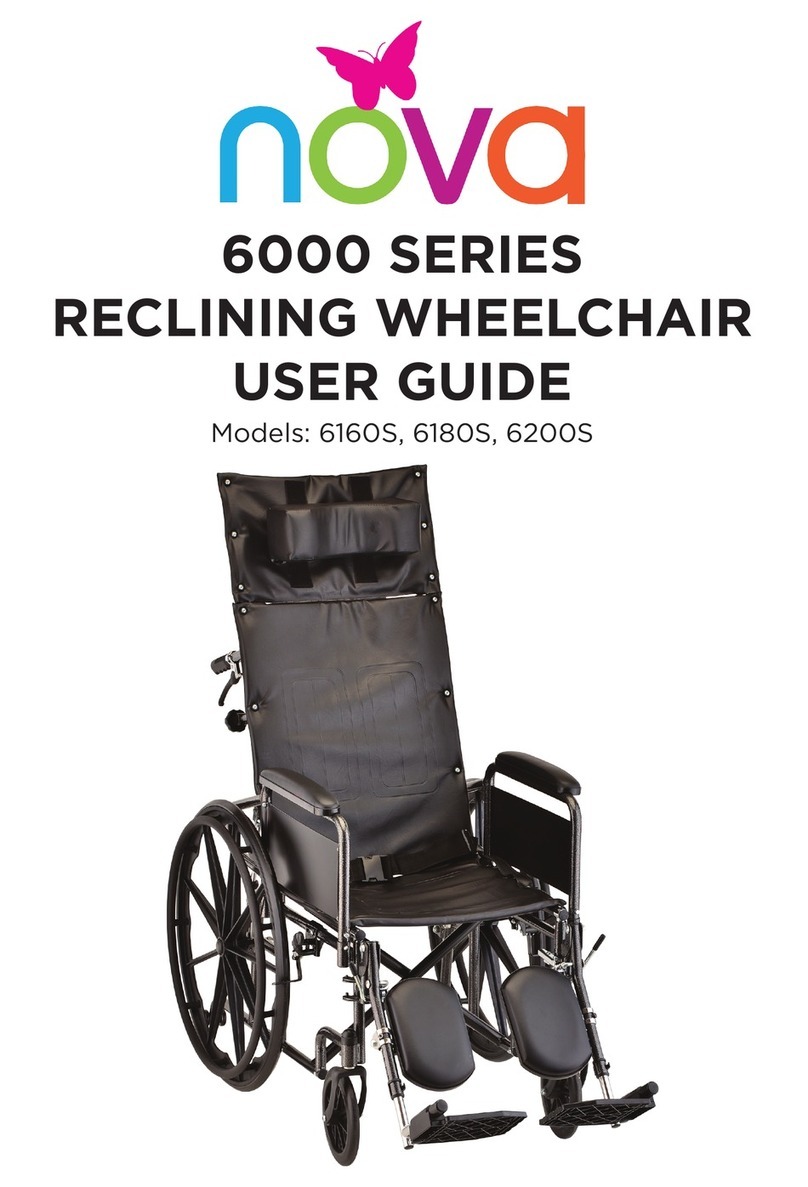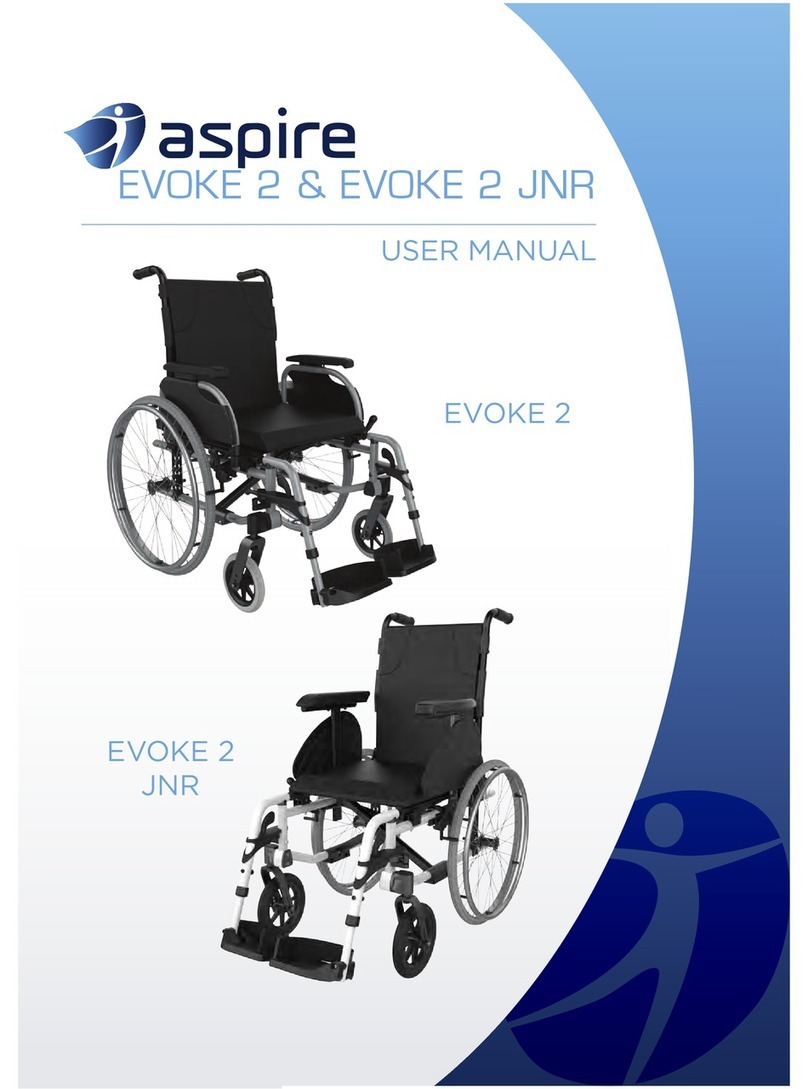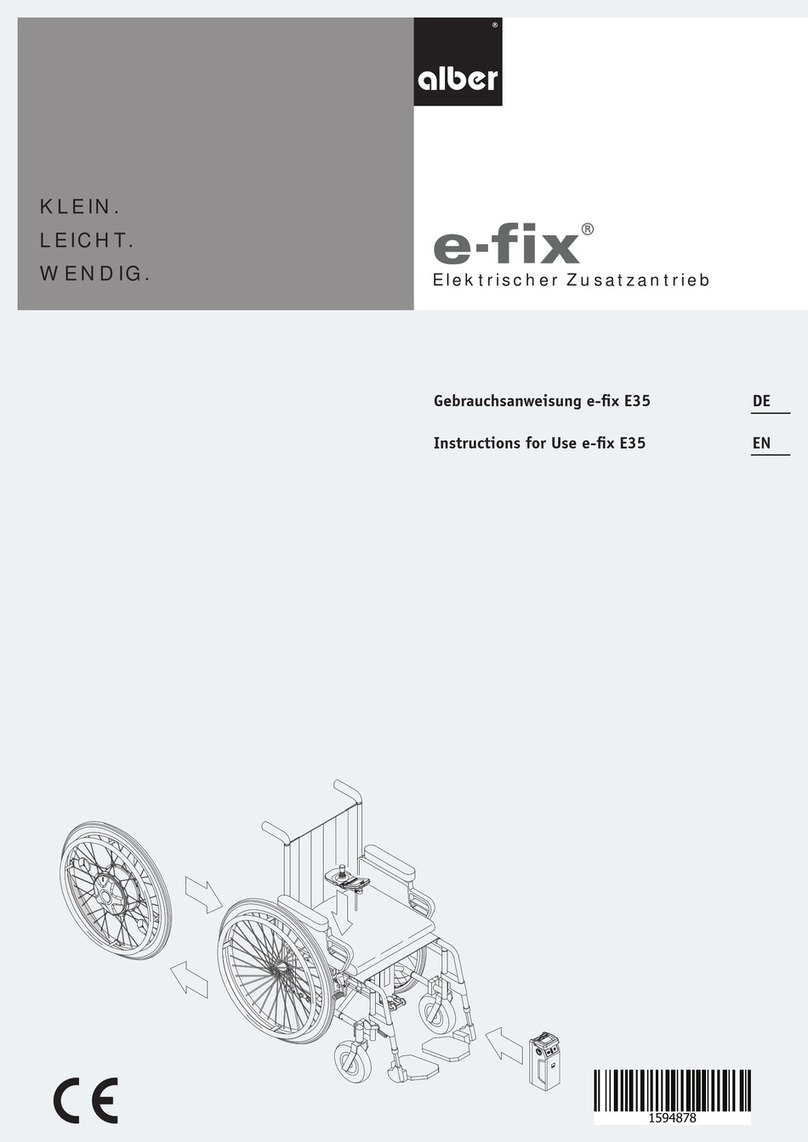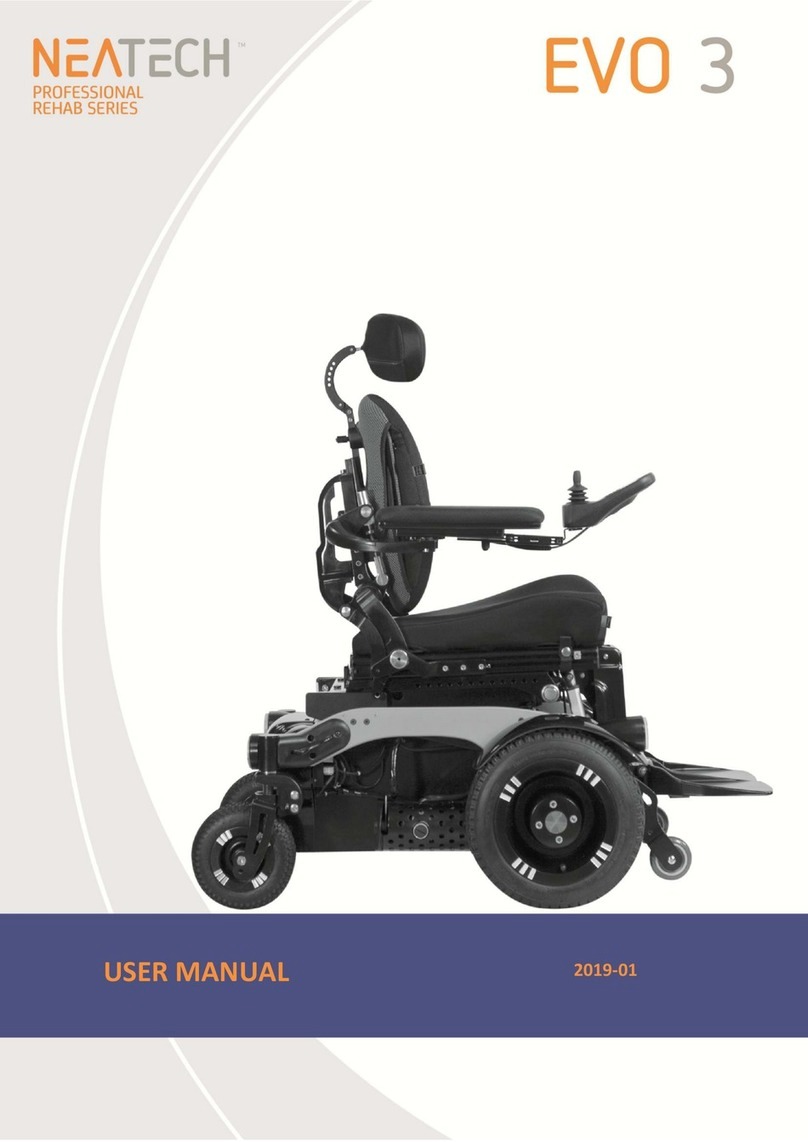Travel Buggy CITY User manual

Foldable Electric Wheelchair
by Travel Buggy
CITY

TABLE OF CONTENTS
CAUTION: Read all precautions and instructions in this manual before using this equipment.
Improper use or maintenance can void the warranty. Keep this manual for future reference.
2
NOTICES 3
SAFETY INFORMATION 4
BATTERY SAFETY INFORMATION 5
SPECIFICATIONS 7
UNBOXING 9
SET UP 10
OPERATING 13
TRANSPORTING 17
BATTERY MAINTENANCE 19
CHARGING 21
MAINTENANCE & CARE 23
TROUBLESHOOTING 24
DIAGNOSTICS 25
LIMITED WARRANTY 26
CONTACT & SUPPORT 27

NOTICES
Thank you for choosing CITY by Travel Buggy,
a convenient to use and portable electric
wheelchair.
It is important to read through this manual before
operating your CITY to become familiar with
its features as well as its limitations and safety
information
You will nd the operation and care of your CITY
very simple and easy, but should you have any
questions please contact Travel Buggy
OUR CUSTOMER HOTLINE
1.888.56.BUGGY (Canada)
1.855.56.BUGGY (USA)
EMAIL
DISCLAIMER:
The notes, warnings, and cautions contained within the manual and marked by the
triangular Caution Symbol should be given special care. Users should also pay special
attention to information marked in this manual beginning with NOTICE.
Travel Buggy, its afliates and partners cannot be held responsible for personal injury or
property damage resulting from the unsafe or improper operation or maintenance of the
CITY Power Wheelchair.
As part of our ongoing product improvement initiative, Travel Buggy reserves the right
to change specications and design without notice. As a result, there may be minor
differences between your CITY and the photos, illustrations and instructions in this manual
3

SAFETY INFORMATION
• DO make certain that the seat is in a
locked position when you are operating
your CITY
• DO reduce your CITY’s speed when you
are driving around a corner
• DO proceed with caution as you
approach the downgrade of a ramp or
other incline and when driving near a
raised surface or unprotected ledges
and drop offs (curbs, porches, stairs, etc.)
• DO avoid exposure to rain, snow, ice, salt,
or standing water whenever possible
• DO maintain and store in a clean and dry
condition
• DO keep your hands away from the tires
when driving. Be aware that loose tting
clothing can become caught in drive
tires
• DO keep tools and other metal objects
away from battery terminals. Contact
with tools can cause electrical shock
• DO follow the recommended weight
capacity (395 lbs / 180 kg)
• DO follow the recommended incline
slope rating (12 degrees / 20% slope)
• DO check the battery charge to ensure
there is enough charge to get to your
destination before using.
• DO ensure your CITY’s power is OFF
when entering and exiting the power
wheelchair
• DO NOT drive your CITY across the side of
a hill or diagonally up or down a hill, and
do not stop (if possible) while driving up
or down an incline
• DO NOT operate your new CITY for the
rst time without completely reading
and understanding the owner’s manual
• DO NOT carry additional passengers on
your CITY
• DO NOT use your CITY as a seat in a
moving vehicle
• DO NOT allow unsupervised children to
play near the power wheelchair
• DO NOT operate your CITY while under
the inuence of alcohol, as this may
impair your ability to drive safely
• DO NOT sit in the CITY while in a moving
vehicle, an accident or sudden stop may
cause you to be thrown from the power
wheelchair
• ALL servicing must be performed by
qualied personnel only. Unauthorized
modications to power wheelchair,
its power system or its control system
may compromise the performance
and safety of the system. UNDER NO
CIRCUMSTANCES should you attempt any
repair or service that is not covered in
this manual.
• ALWAYS ensure all safety warning labels
are in place and legible.
4
WARNING:The operator should read all of the warnings signs and instructions here and on the power wheelchair before use.
WARNING: Always protect batteries from freezing temperatures and never charge a frozen battery. This will damage the battery and
may cause personal injury. Attempting to charge a battery in freezing conditions does not prevent a battery from freezing.
WARNING: You should not operate your scooter on public streets and roadways. Be aware that it may be difcult for trafc to see you
when you are seated on your power wheelchair. Obey all local pedestrian trafc rules. Wait until your path is clear of trafc, and then
proceed with extreme caution.

BATTERY SAFETY INFORMATION
WHEN USING THE BATTERY
1. Lithium-ion battery packs may get hot,
explode or ignite and cause serious
injury if exposed to abuse conditions. Be
sure to follow the safety warnings listed
below:
• DO NOT place the battery near re or
heat the battery
• DO NOT install the battery backwards
so the polarity is reversed
• DO NOT connect the positive and
negative terminal of the battery to
each other with any metal object
(such as a wire)
• DO NOT carry or store the battery
together with necklaces, hairpins, or
other metal objects
• DO NOT pierce the battery with nails
strike the battery with a hammer,
step on the battery or otherwise
subject it to strong impacts or shocks
• DO NO solder directly onto the
battery
• DO NOT expose battery to water or
salt water, or allow the battery to get
wet
2. DO NOT disassemble or modify the
battery. The battery contains safety and
protection devices, which if damaged,
may cause the battery to generate heat,
explode or ignite
3. DO NOT place the battery in or near re,
on stoves or other high temperature
locations. Do not place the battery in
direct sunlight, or use or store batteries
inside cars in hot weather. Doing so may
cause the battery to generate heat,
explode or ignite. Using the battery in
this manner may also result in a loss
of performance and a shortened life
expectancy.
4. If the device is to be used by children, the
caregiver should explain the contents
of this document to the children and
provide adequate supervision to ensure
the device is being used appropriately
5. When the battery is worn out, insulate
the terminals with adhesive tape or
similar materials before disposal
6. Immediately discontinue use of the
battery if, while using, charging or
storing the battery, the battery emits an
unusual smell, feels hot, changes color,
or shape, or appears abnormal in any
way. Contact Travel Buggy if any of these
problems are observed
7. DO NOT place battery in microwave over,
high pressure containers or on induction
cookware
5

6
BATTERY SAFETY INFORMATION
CHARGING PRECAUTIONS
1. BE SURE to follow the warnings listed
below while charging the battery. Failure
to do so may cause the battery to
become hot, explode or ignite and cause
serious injury.
• When charging the battery, ONLY USE
THE SPECIFIED CHARGER PROVIDED
WITH THE PRODUCT
• DO NOT attach the battery to a
power supply plug or directly to a
car’s cigarette lighter
• DO NOT place the battery in or near
re, or in direct sunlight. Heating
the battery can damage the safety
circuitry, which can cause additional
heating, rupture or ignition of the
battery
2. DO NOT continue charging the battery
if it does not recharge in the timelines
specied in the operating manual
3. THE TEMPERATURE range over which a
battery can be charged is 0°C to 45°C
(32°F to 113°F). Charging the battery at
temperatures outside of that range may
cause severe damage to the battery or
reduce battery life expectancy
WHEN DISCHARGING THE BATTERY
1. DO NOT discharge the battery using any
other device except for the specied
device. When the battery is used in
devices other than the specied device,
it may damage the battery or reduce
its life expectancy. If the device causes
abnormal current ow, it may cause the
battery to become hot, explode or ignite
and cause serious injury.
2. THE TEMPERATURE range over which the
battery can be discharged is -20°C to
60°C (-4°F to 140°F). Use of the battery
outside this temperature range may
damage the performance of the battery
or may reduce its life expectancy.

SPECIFICATIONS
SHOCK ABSORPTION
SPRINGS
ARMRESTS
EASY TO USE CONTROLLER
SERIAL NUMBER UNDER
PUSH HANDLE CUSHION
SEAT BACK/
PUSH HANDLE
BACKREST CUSHION
WITH STORAGE BAG
FOOT REST
STORAGE BAG
LITHIUM-ION
BATTERY (2)
OVERALL HEIGHT 38”
OVERALL LENGTH 37” OVERALL WIDTH 23”
BACK REST 18.5” FLOOR TO SEAT 19.5”
SEAT DEPTH 16”
SEATING WIDTH 19.5” / 21.5”
12” NON-PUNCTURE
REAR WHEEL
250 WATT
BRUSHLESS MOTORS
8” NON-PUNCTURE
FRONT WHEEL
WASHABLE SEAT CUSHION
7

PERFORMANCE SPECIFICATIONS
DRIVING RANGE: 15.5 MI / 25 KM
MAXIMUM SPEED: 4 MPH / 6 KPH
DRIVE SYSTEM: TWO MOTOR DRIVE SYSTEM
MOTOR TYPE: 250 WATT BRUSHLESS
INCLINE CAPABILITY: 12° / 21.3%
TURNING RADIUS: 33”
STOPPING DISTANCE: 5 FT (AT FULL SPEED)
OBSTACLE CLEARANCE: 1.5”
BRAKING SYSTEM: ELECTROMAGNETIC
MAX WEIGHT CAPACITY: 395 LBS
DIMENSIONAL SPECIFICATIONS
UNFOLDED DIMENSIONS: 38”L X 23”W X
37”H
CHAIR GROSS WEIGHT: 58.5 LBS
CHAIR NET WEIGHT: 52 LBS (NO BATTERIES)
SEAT CUSHION SIZE: 18.5” (W) X 16.5” (D)
FOLDED DIMENSIONS: 23”L X 13”W X 31”H
SEATING WIDTH: STANDARD 19.5”, WIDE
21.5”
FRONT WHEEL DIAMETER: 8”
REAR WHEEL DIAMETER: 12”
FLOOR TO SEAT HEIGHT: 19.5”
BACK SUPPORT HEIGHT: 18.5”
OTHER SPECIFICATIONS
BATTERY TYPE: LITHIUM-ION (24V X 6AH)
BATTERIES PROVIDED: TWO (2)
BATTERY WATT HOUR: 144 WH (AIRLINE
APPROVED)
BATTERY CHARGE CYCLES: ~1,000
TIRES: NON-PUNCTURE
CHARGING TIME: 6 TO 8 HOURS
CHARGER INPUT: 100-240V, 50/60HZ
(INTERNATIONAL)
CHARGER OUTPUT: 29.4V 2.0A
LAP BELT: PROVIDED
HORN: BUILT-IN
SPECIFICATIONS
8

UNBOXING
• Open the top of the box as received and
remove the foam lid inside the package
• To remove he electric wheelchair,
orientate the box such that when it is
laid down on the ground the padded bar
is at the top and the footplate is at the
bottom
• Grab the padded bar at the top and
begin to pull your Travel Buggy out
horizontally parallel with the ground.
BOTTOM
TOP
9
• Locate the components provided with your power wheelchair
SEAT CUSHION
BATTERY CHARGERJOYSTICK CONTROLLER
LITHIUM
BATTERY (2)*
BACK REST
CUSHION
LAP BELT PIG TAIL BOLTS X4
TOOLS
NOTICE: Lithium Batteries are already installed and charged on the power chair when shipped.

SET UP
10
• Balance the chair on the rear wheels
in the upright position. Next, grasp the
padded bar at the top of the chair while
pushing down on the seat to unfold the
electric wheelchair like a lawn chair
• Continue to expand the chair into a
seated position until you hear a *CLICK*
indicating it has locked into the seated
position.

SET UP
11
• Locate the seat cushion and back rest
cushion provided.
• Orientate the seat cushion such that the
zipper of the cushion will be at the rear
of the seat and the Velcro on the bottom
of the seat cushion aligns with the Velcro
on the seat (Image 1).
• Next, place the back rest cushion under
the padded bar and on either side of the
back rest tension straps (Image 2).
• Be sure the Travel Buggy logo is at
the rear. Press the back rest cushion
together on either side to adhere to the
Velcro of the back rest.
NOTICE: There are tension straps located on the seat and backrest to increase the rmness of the seating position.
Simply unfasten, tighten, then fasten them again into place to change the tension of the seat and backrest.
1
2

SET UP
12
• Locate the joystick controller in the stor-
age pouch below the power chair.
• Slide the joystick controller into the arm
rest tube until it is fully inserted (image 1),
you may need to loosen corkscrew to
insert fully
• Tighten the corkscrew to secure the joy-
stick (image 2)
• Align the arrows of the joystick connec-
tion cables and press them together to
plug the joystick controller in (image 3)
• Rotate the coupling over the connection
point to secure the connection point
(image 4)
• Joystick can be positioned on left or right
arm rest
• To change joystick position, rst remove
the joystick by performing the opposite
sequence of the steps above
• Remove the rubber plug at the front of
the arm rest tube and place back in the
unused arm rest
• Next, unscrew the wire harness under
the armrest (1) cut the plastic ties on the
frame of the chair (2) to create slack in
the joystick power cable
• Move the power cable to the opposite
side and re-fasten using the wire
harness and plastic ties, be sure the
cable is not interfering with the folding or
movement of the electric wheelchair
• Connect the joystick
1
1
3 4
2
2
2

OPERATING
• To enter on the side, rotate the arm rest lock clockwise to the UP position and lift the arm rest
vertical to provide the required clearance
• NOTICE: If the arm rest gets stuck in the vertical position, simply pull from the mid-section of the
arm rest to release it (indicated by 1 above)
• Before sitting in the electric wheelchair,
be sure the power button is OFF and
the rear brake levers are in the DOWN
(locked) position
• CITY offers the user 2 optional entry
alternatives, direct front entry or side
entry
• If you prefer a front entry, we
recommend ipping up the foot plate to
create an easier sitting experience
• DO NOT step on the footplate when
entering or exiting the CITY as it may
cause the power chair to move in an
unsafe manner
1
13

14
OPERATING
• CITY electric wheelchair has an easy to use 360 degree joystick controller featuring multiple
speeds and a battery life indicator
• Take some time in a safe, controlled environment to learn the operation of the controller, the
speed and the maneuverability of the CITY
• Be sure to adjust the speed depending on your environment and while turning
• To slow down, slowly bring the joystick back toward the initial position.
• To stop, just bring the joystick back to the initial position
• Use extra care when you drive the CITY in reverse

15
OPERATING
• In order to have a care giver push the
CITY, it must be put in Free Wheel mode
• This mode disengages the drive
mechanism to the wheels, making them
free to push manually
• To put the CITY in Free Wheel Mode,
come to a full stop and turn OFF the
power on the controller.
• Push UP on the two red levers located on
each rear wheel as shown
FREE WHEEL/
MANUAL MODE (UP)
LOCKED/ POWER
MODE (DOWN)

16
OPERATING
• Your CITY model may have come with a
reclining backrest
• This allows the user to recline the back
rest into multiple positions for comfort
• To release the back rest, push UP on the
lever at the back of the back rest (1) while
simultaneously pulling down from the
top bar of the back rest frame (2)
• Release the lever to lock the back rest
into the desired position
1
2
WARNING: DO NOT attempt to recline the chair while seated in the CITY power wheelchair.

17
TRANSPORTING
• Turn OFF your CITY power wheelchair
• We recommend removing the seat cushion and joystick prior to folding
• Unlock the frame latch (1) while simultaneously beginning the folding process
• Continue the folding process by holding one hand beneath the seat frame and another on the
top bar (2), similar to a lawn chair
• Once folded, the power chair can balance on its rear wheels (3)
• To move the CITY, we recommend fastening the power chair into the folded position with the
nylon lap belt provided with your CITY
• Next, release the wheels to allow the CITY to move freely by pressing UP on the rear brake
switches as indicated (4)
• Finally, the footrest (or suitcase handle add-on) can be used to pull the CITY easily once the
brakes are released
FREE WHEEL/
MANUAL MODE (UP)
1 3
4 5
2

18
TRANSPORTING
• To load the CITY electric wheelchair into
the back of a vehicle for transport we
recommend utilizing the back of the
vehicle as leverage
• Position the power chair against the
car as indicated in Image 1 (Note:
we recommend a blanket to reduce
scratching of the vehicle)
• LOCK the brakes by pressing down on
the rear brake switches
• Once LOCKED, grasp the rear wheels
(Image 2)
• Lift against the back of the vehicle,
leveraging the power wheelchair into
the trunk of the vehicle (Image 3)
• Push the CITY into the desired position
within the vehicle (Image 4)
WARNING: Never transport the CITY in a tie down system, as the CITY is not compatible with them. Never sit in the CITY and be
transported in a moving vehicle. Do not place the folded CITY in the front seat with the driver where it could move or slide.
1 2
43

19
BATTERY MAINTENANCE
Lithium-Ion rechargeable batteries require
routine maintenance and care in their use and
handling. Read and follow the guidelines in this
document to safely use Lithium-Ion batteries and
achieve the maximum battery life span.
OVERVIEW
Do not leave batteries unused for extended
periods of time, either in the product or in storage.
When a battery has been unused for 6 months,
check the charge status and charge or dispose
of the battery as appropriate.
The typical estimated life of a Lithium-Ion
battery is about three years or ~500 charge
cycles, whichever occurs rst. One charge cycle
is a period of use from fully charged, to fully
discharged, and fully recharged again. Use a
three-year life expectancy for batteries that do
not run through complete charge cycles.
Rechargeable Lithium-Ion batteries have a
limited life and will gradually lose their capacity
to hold a charge. This loss of capacity (aging)
is irreversible. As the battery loses capacity, the
length of time it will power the product (run time)
decreases.
Lithium-Ion batteries continue to slowly discharge
(self-discharge) when not in use or while in
storage. Routinely check the battery’s charge
status.
Use only the provided battery(s) in your product.
Use only the provided charger to charge your
battery(s).
BATTERY MAINTENANCE
Observe and note the run time that a new fully-
charged battery provides for powering your
product. Use this new battery run time as a basis
to compare run times for older batteries. The run
time of your battery will vary depending on the
product’s conguration and the applications that
you run.
Routinely check the battery’s charge status.
Carefully monitor batteries that are approaching
the end of their estimated life.
Consider replacing the battery with a new one if
you note either of the following conditions:
• The battery run time drops below about 80%
of the original run time.
• The battery charge time increases
signicantly.
If a battery is stored or otherwise unused for an
extended period, be sure to follow the storage
instructions in this document. If you do not follow
the instructions, and the battery has no charge
remaining when you check it, consider it to be
damaged. Do not attempt to recharge it or to use
it. Replace it with a new battery.
CHARGING
Always follow the charging instructions provided
with your product. Refer to your product’s
user manual and/or online help for detailed
information about charging its battery.
Use only the provided charger to charge your
battery.
WARNING: DO NOT charge the batteries for greater than 8 hours, this will signicantly reduce the longevity of the lithium ion batteries
and be of harm to the user.
NOTE: When you troubleshoot battery issues for dual battery congurations, test one battery and one battery slot at a time. A defective
battery can prevent the battery in the opposite slot from charging, leaving you with two uncharged batteries.

20
BATTERY MAINTENANCE
STORAGE
• Charge or discharge the battery to
approximately 50% of capacity before
storage.
• Charge the battery to approximately 50% of
capacity at least once every six months.
• Remove the battery and store it separately
from the product.
• Store the battery at temperatures between 5
°C and 20 °C (41 °F and 68 °F).
HANDLING PRECAUTIONS
• Do not disassemble, crush, or puncture a
battery.
• Do not short the external contacts on a
battery.
• Do not expose a battery to re or water.
• Do not expose a battery to temperatures
above 60 °C (140 °F).
• Keep the battery away from children.
• Avoid exposing the battery to excessive
shock or vibration.
• Do not use a damaged battery.
• If a battery pack has leaking uids, do not
touch any uids.
• Dispose of a leaking battery pack (see
Disposal and Recycling in this document).
• In case of eye contact with uid, do not rub
eyes. Immediately ush eyes thoroughly with
water for at least 15 minutes, lifting upper
and lower lids, until no evidence of the uid
remains. Seek medical attention.
• Immediately discontinue use of the battery if,
while using, charging or storing the battery,
the battery emits an unusual smell, feels
hot, changes color, or shape, or appears
abnormal in any way. Contact Travel Buggy if
any of these problems are observed
TRANSPORTATION
• Always check all applicable local, national,
and international regulations before
transporting a Lithium-Ion battery.
• Transporting an end-of-life, damaged, or
recalled battery may, in certain cases, be
specically limited or prohibited.
DISPOSAL AND RECYCLING
• Lithium-Ion batteries are subject to disposal
and recycling regulations that vary by
country and region. Always check and follow
your applicable regulations before disposing
of any battery. Contact Rechargeable Battery
Recycling Corporation (www.rbrc.org) for
U.S.A. and Canada, or your local battery
recycling organization.
• Many countries prohibit the disposal of waste
electronic equipment in standard waste
receptacles.
• Place only discharged batteries in a battery
collection container. Use electrical tape or
other approved covering over the battery
connection points to prevent short circuits.
NOTE: The battery self-discharges during storage. Higher temperatures (above 20 °C or 68 °F) reduce the battery storage life.
Table of contents
Languages:
Other Travel Buggy Wheelchair manuals
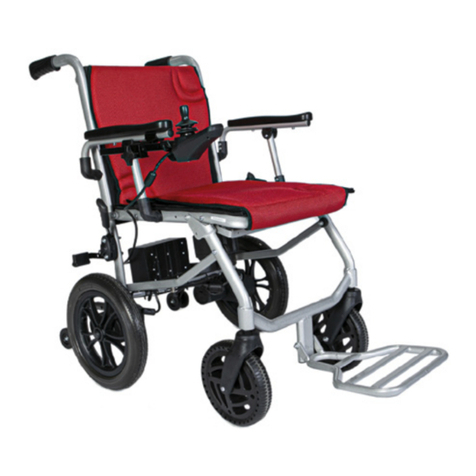
Travel Buggy
Travel Buggy DASH Ultra Lite Power User manual

Travel Buggy
Travel Buggy DASH Ultra Lite Power User manual

Travel Buggy
Travel Buggy VISTA User manual

Travel Buggy
Travel Buggy DASH User manual

Travel Buggy
Travel Buggy CITY 2 PLUS User manual
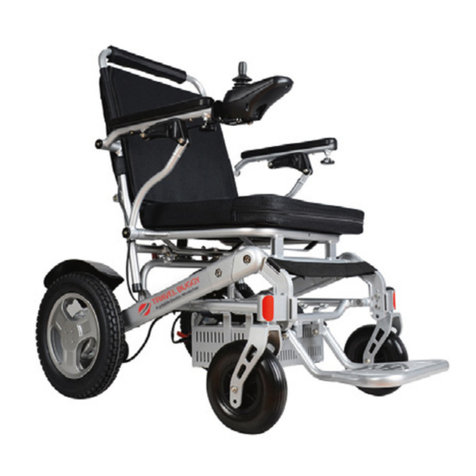
Travel Buggy
Travel Buggy CITY PLUS User manual

Travel Buggy
Travel Buggy CITY 2 PLUS User manual







